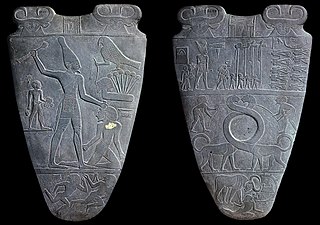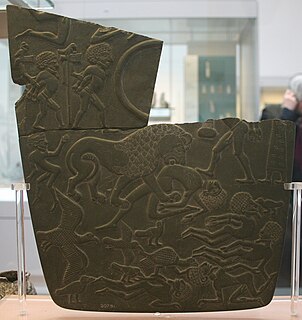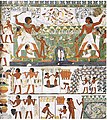
The Narmer Palette, also known as the Great Hierakonpolis Palette or the Palette of Narmer, is a significant Egyptian archeological find, dating from about the 31st century BC, belonging, at least nominally, to the category of cosmetic palettes. It contains some of the earliest hieroglyphic inscriptions ever found. The tablet is thought by some to depict the unification of Upper and Lower Egypt under the king Narmer. On one side, the king is depicted with the bulbed White Crown of Upper (southern) Egypt, and the other side depicts the king wearing the level Red Crown of Lower (northern) Egypt. Along with the Scorpion Macehead and the Narmer Maceheads, also found together in the main deposit at Nekhen, the Narmer Palette provides one of the earliest known depictions of an Egyptian king. The Palette shows many of the classic conventions of Ancient Egyptian art, which must already have been formalized by the time of the Palette's creation. The Egyptologist Bob Brier has referred to the Narmer Palette as "the first historical document in the world".

Deshret was the formal name for the Red Crown of Lower Egypt and for the desert Red Land on either side of Kemet, the fertile Nile river basin. When combined with the Hedjet of Upper Egypt, it forms the Pschent, in ancient Egyptian called the sekhemti.
This is a glossary of ancient Egypt artifacts.
The ancient Egyptian Harpoon,, is one of the oldest language hieroglyphs from ancient Egypt. It is used on the famous Narmer Palette of Pharaoh Narmer from the 31st century BC, in an archaic hieroglyphic form.

The ancient Egyptian Mast hieroglyph is one of the oldest language hieroglyphs from Ancient Egypt. It is used on a famous label of Pharaoh Den of the First dynasty, but forms part of the location hieroglyph: Emblem of the East.
The ancient Egyptian horizontally-outstretchedArm with powerstick is a hieroglyph with the meaning of "force", or "power of action". As a baton, or macehead. Power is obvious, but the origins may have also had references to magic, or the idea of driving-off bad spirits or omens.

The ancient Egyptian Man-prisoner is one of the oldest hieroglyphs from Ancient Egypt. An iconographic portrayal from predynastic Egypt eventually led to its incorporation into the writing system of the Egyptian language. Not only rebels from towns or districts, but foreigners from battle were being portrayed.
The ancient Egyptian Hand hieroglyph is an alphabetic hieroglyph with the meaning of "d"; it is also used in the word for 'hand', and actions that are performed, i.e. by the 'way of one's hands', or actions.
The Foreleg of ox hieroglyph of ancient Egypt is an old hieroglyph; it even represented a nighttime constellation. It came to have many uses in ancient Egypt over three millennia.

The Battlefield Palette may be the earliest battle scene representation of the dozen or more ceremonial or ornamental cosmetic palettes of ancient Egypt. Along with the others in this series of palettes, including the Narmer Palette, it includes some of the first representations of the figures, or glyphs, that became Egyptian hieroglyphs. Most notable on the Battlefield Palette is the standard, and Man-prisoner hieroglyph, probably the forerunner that gave rise to the concept of the Nine bows.
The ancient Egyptian Papyrus stem hieroglyph is one of the oldest language hieroglyphs from Ancient Egypt. The papyrus stalk, was incorporated into designs of columns on buildings, also facades, and is also in the iconographic art portrayed in ancient Egyptian decorated scenes.

The Hunters Palette or Lion Hunt Palette is a circa 3100 BCE cosmetic palette from the Naqada III period of late prehistoric Egypt. The palette is broken: part is held by the British Museum and part is in the collection of the Louvre.

The Bull Palette is the fragment of an Ancient Egyptian greywacke palette, carved in low relief and used, at least in principle, as a cosmetic palette for the grinding of cosmetics. It is dated to Naqada III, the final two centuries of the fourth millennium BC, immediately preceding the Early Dynastic Period). It is in the collection of the Louvre, inventory no. E11255.

The Egyptian hieroglyph representing gold, phonetic value nb, is important due to its use in the Horus-of-Gold name, one of the Fivefold Titulary names of the Egyptian pharaoh.
The ancient Egyptian Branch hieroglyph, also called a Stick, is a member of the trees and plants hieroglyphs.

The ancient Egyptian Townsite-city-region (hieroglyph) is Gardiner sign listed no. O49 for the intersection of a town's streets. In some Egyptian hieroglyphs books it is called a City Plan.
The Ancient Egyptian Swallow hieroglyph is Gardiner sign listed no. G36 for swallow birds. The Sparrow hieroglyph appears similar in size and shape, but it is used to represent small, or bad items.

The ancient Egyptian Bull (hieroglyph), Gardiner sign listed no. E1, is the representation of the common bull. The bull motif is dominant in protodynastic times, and also has prominence in the early dynastic Egypt, famously on the Narmer Palette. Its phonetic value is kꜣ.















